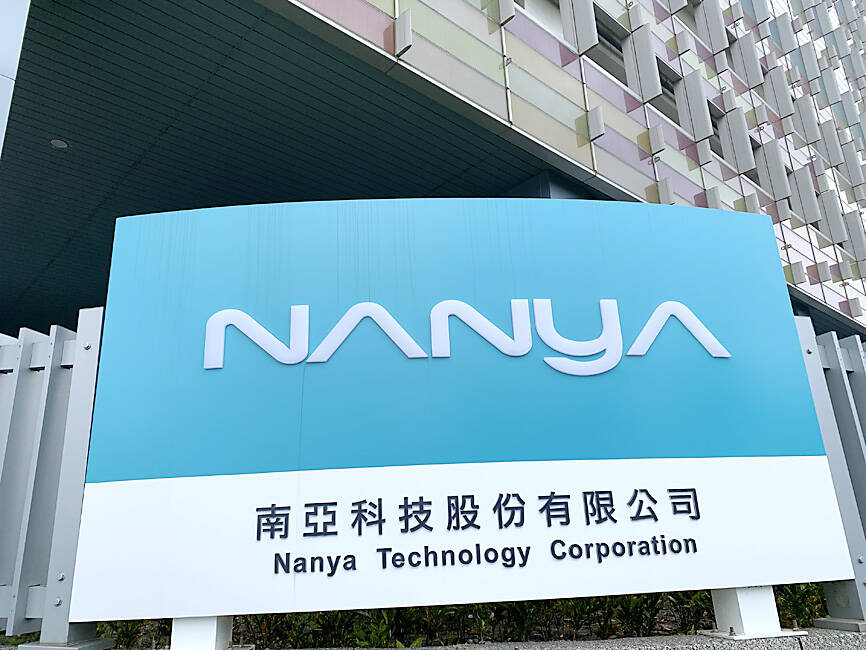DRAM chipmaker Nanya Technology Corp’s (南亞科技) losses widened in the second quarter due to foreign-exchange losses and lower chip prices, but the company expects a pickup in demand to help it return to profit in the fourth quarter at the earliest.
Foreign-exchange losses of NT$1.12 billion (US$38.3 million) in the second quarter due to the New Taiwan dollar’s sharp rise against the greenback contributed 25 percent to the company’s net losses of NT$4.11 billion, the chipmaker said yesterday.
Second-quarter losses were larger than the losses of NT$1.94 billion in the first quarter and marked the 11th consecutive money-losing quarter, it said.

Photo: Grace Hung, Taipei Times
Average selling prices dipped about 5 percent sequentially or 15 percent annually in the second quarter, although shipments soared about 70 percent sequentially or 30 percent annually, the company said.
“We are positive about [memorychip] pricing in the second half,” Nanya president Lee Pei-ing (李培瑛) told a virtual media briefing yesterday.
The prices of DRAM chips used in non-artificial intelligence (AI) applications started to pick up last month, as supply and demand reached parity, and the uptrend is likely to extend into the second half, Lee said.
Non-AI DRAM chips account for 90 percent of the total DRAM market, he said.
“Price negotiations for the third quarter have gone very smoothly,” Lee said. “It is highly likely that Nanya would start to eke out a profit in the fourth quarter, rather than in the third quarter.”
Gross margin is likely to return to positive territory in the third quarter, from minus-20.6 percent in the second quarter, the company said.
Factory utilization rate has reached 100 percent, and the company is boosting production of DDR4 and low-power DDR4 DRAM chips in response to rising demand, it said.
The company continues to produce DDR4 and low-power DDR4 DRAM memory chips, with DDR4 DRAM accounting for more than half of its total production, while major global players are allocating more capacity to produce high-bandwidth memory or DDR5 DRAM chips to cope with booming demand for AI servers, it said.
Nanya said it is leveraging its second-generation 10-nanometer process technology to produce some low-power DDR5 DRAM chips, DDR4 and low-power DDR4 DRAM chips.
Regarding the impact of looming US tariffs on Taiwan, the company said that customers have not acted proactively and it expects limited impact from the potential US duties on semiconductors.
Manufacturers of logic chips would face a greater tariff impact than memorychip makers, Lee said.
As Taiwan’s logic chipmakers are well-positioned in the market, US duties on semiconductors are not expected to exert a significant influence on local firms as they are capable of passing on tariff costs to customers, he said.

WEAKER ACTIVITY: The sharpest deterioration was seen in the electronics and optical components sector, with the production index falling 13.2 points to 44.5 Taiwan’s manufacturing sector last month contracted for a second consecutive month, with the purchasing managers’ index (PMI) slipping to 48, reflecting ongoing caution over trade uncertainties, the Chung-Hua Institution for Economic Research (CIER, 中華經濟研究院) said yesterday. The decline reflects growing caution among companies amid uncertainty surrounding US tariffs, semiconductor duties and automotive import levies, and it is also likely linked to fading front-loading activity, CIER president Lien Hsien-ming (連賢明) said. “Some clients have started shifting orders to Southeast Asian countries where tariff regimes are already clear,” Lien told a news conference. Firms across the supply chain are also lowering stock levels to mitigate

NEW PRODUCTS: MediaTek plans to roll out new products this quarter, including a flagship mobile phone chip and a GB10 chip that it is codeveloping with Nvidia Corp MediaTek Inc (聯發科) yesterday projected that revenue this quarter would dip by 7 to 13 percent to between NT$130.1 billion and NT$140 billion (US$4.38 billion and US$4.71 billion), compared with NT$150.37 billion last quarter, which it attributed to subdued front-loading demand and unfavorable foreign exchange rates. The Hsinchu-based chip designer said that the forecast factored in the negative effects of an estimated 6 percent appreciation of the New Taiwan dollar against the greenback. “As some demand has been pulled into the first half of the year and resulted in a different quarterly pattern, we expect the third quarter revenue to decline sequentially,”

Six Taiwanese companies, including contract chipmaker Taiwan Semiconductor Manufacturing Co. (TSMC), made the 2025 Fortune Global 500 list of the world’s largest firms by revenue. In a report published by New York-based Fortune magazine on Tuesday, Hon Hai Precision Industry Co. (better known as Foxconn) ranked highest among Taiwanese firms, placing 28th with revenue of US$213.69 billion. Up 60 spots from last year, TSMC rose 60 places to reach No. 126 with US$90.16 billion in revenue, followed by Quanta Computer Inc. at 348th, Pegatron Corp. at 461st, CPC Corp., Taiwan at 494th and Wistron Corp. at 496th. According to Fortune, the world’s

DIVERSIFYING: Taiwanese investors are reassessing their preference for US dollar assets and moving toward Europe amid a global shift away from the greenback Taiwanese investors are reassessing their long-held preference for US-dollar assets, shifting their bets to Europe in the latest move by global investors away from the greenback. Taiwanese funds holding European assets have seen an influx of investments recently, pushing their combined value to NT$13.7 billion (US$461 million) as of the end of last month, the highest since 2019, according to data compiled by Bloomberg. Over the first half of this year, Taiwanese investors have also poured NT$14.1 billion into Europe-focused funds based overseas, bringing total assets up to NT$134.8 billion, according to data from the Securities Investment Trust and Consulting Association (SITCA),